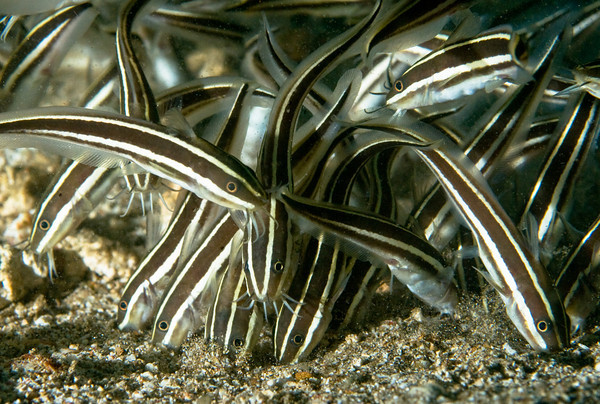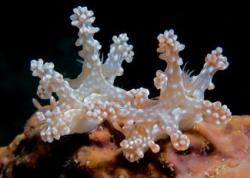Marine Life Behavior
Doing your research on a dive site will help you know beforehand what type of behavior shots to target. Having a good guide or local knowledge is essential for maximizing your opportunities.
Examples of Marine Life Behavior
Predation underwater
Ambush predators, like bobbit worms, lizardfish, or flamboyant cuttlefish, strike at a moment's notice. Some predation shots take a lot of waiting.

Bobbit worm eating a fish. Anilao, Philippines. D300, 60mm lens. F8, 1/320th, ISO 250. This moment happens faster than you can see, you only get one shot. Read more about the bobbit worm, with more close-up photos.
Feeding

Catfish feeding, Anilao, Philippines. F9, 1/250th, ISO 200

Bat ray eating a dead squid, Redondo beach, California. Fuji F10, F2.8, 1/100th

Nudibranch eating a hydroid. 105mm with SubSee +10 diopter. F32, 1/320th, ISO250. Catalina Island, California, USA.
Underwater cleaning stations
- Watch for wrasses or shrimps waiting to clean larger fish, these areas are called cleaning stations. With cleaning stations, long lenses help, and you have to be careful not to scare the fish away. Don't approach from above.

Long lenses such as a 100/105mm (150mm on a full frame) work well for cleaning shots. Batfish getting a cleaning from a wrasse. Nikon D80, 105mm lens, Bali. F8, 1/160th, ISO 200

Moray eel and cleaner shrimp, Bali. 60mm lens, F22, 1/60th, ISO 250

A giant kelpfish trying to get cleaned by my wife. Catalina island, California. Nikon D80, 10-17mm fisheye. F10, 1/100th, ISO 200.

Giant Mola mola getting cleaned, Tepekong, Bali. Nikon D80, 60mm lens. F5.6, 1/100th, ISO 100
Fish throwing out a lure
- Frogfish will often have a lure that swings forward and back

Frogfish, Antennarius maculatus, throwing out its lure. Anilao, Philippines. A little patience will allow you to capture this, the lure comes out every couple of minutes.
Fish carrying eggs
- Fish like Cardinal fish, Jawfish, seahorses, pipefish will sometimes be carrying eggs. Carrying eggs in the mouth is called brooding. You can read our article on mouthbrooding cardinal fish.

Always check pipefish to see if they are carrying eggs. Nikon D300, 60mm + 1.4x tele, Anilao, Philippines. F16, 1/320th, ISO 250

Sarcastic fringehead guarding its eggs. Photo by Penelope Foo. San Diego, California. Fuji F30.

Brooding cardinalfish, photo by Mike Bartick.
Marine life laying eggs

Garibaldis fertilizing eggs, Farnsworth Banks, California. Nikon D80, 10-17mm fisheye, F8, 1/100th.

Squid laying an egg. Redondo beach, California. Fuji F10, F8, 1/100th.

Cuthona divae nudibranch laying eggs, Palos Verdes, California.
Mating
- Squid, octopus, nudibranchs, mandarin fish and other species all have interesting mating rituals.
Mandarin fish mating
Mating mandarin fish is a beautiful underwater scene. They mate at dusk, usually coming out of staghorn coral in shallow water.

Mating Mandarin fish. F16, 60mm lens, Nikon D200, single Subtronic strobe. Photo by Uwe Schmolke. "The reason I like this image a lot, is because it is taken in intact hard coral life and not in broken coral rubble. Hard to focus in the night with just little light by the Pilotlamp in the strobe."

Squid mating, photo by Cal Mero. Nikon D80, F16, 1/90th, 60mm lens. "I had to lie flat on the sand and photograph up into the water column to separate the squid from their cluttered background. This enabled me to highlight their features and capture this unusual behavior shot."

Mating nudibranchs, Anilao, Philippines. D300, 60mm lens, F11, 1/250th, ISO 250

Mating stingrays, Catalina Island, California. Nikon D80, 10-17mm fisheye, F7, 1/30th, ISO 320. These stingrays dispersed moments after this shot. Sometimes one shot is all you get. Be ready.

Mating squid, Los Angeles, CA. 60mm lens, F10, 1/250th, ISO 200. When good behavior is happening, spend as long of a time as you can taking shots. If you think the behavior will continue come back for more dives. Mark the area underwater somehow, and take careful depth readings. Use the best lens you have for the shots. In this case, the first time I saw the mating I had on a teleconverter. I came back the next night without the teleconverter to get some closer shots, and luckily the mating was still going on.
Fish Fighting
- Wrasses and rockfish will often fight for dominance.

Tobies fighting for dominance. Anilao, Philippines. Nikon D300, 60mm lens. F8, 1/250th, ISO 200. These tobies were separate, but would suddenly swim together and bump heads at high speed. It took several attempts and patient waiting to capture this moment.

Sheephead wrasse fighting for dominance. Catalina Island, California. Nikon D80, 16mm fisheye. F6.3, 1/60th, ISO 400. They broke up immediately after this shot.
Mimicking
- Octopus, squid, cuttlefish will often mimic their surroundings

This small squid started mimicing objects in its surroundings to try to confuse me. Anilao, Philippines. Nikon D300, 60mm + 1.4x tele, F20, 1/320th, ISO 200
Marine life flashing & warning
- Squid, Octopus and Cuttlefish can flash colors to display emotions. Other animals warn in different ways.

Sea lion giving warning bubbles. Anacapa island, California. Nikon D80, 10-17mm fisheye, F7, 1/100th, ISO 200
Yawning fish
- Use a mirror to make a jawfish yawn. Rhinopias and frogfish occasionally yawn. Fringeheads open their mouth wide as a prelude to an attack. Some people have waited a long time for a yawn.

Commonsal's frogfish taking a yawn. Anilao, Philippines. Nikon D300, 10-17mm fisheye, F13, 1/320th, ISO 200

Rhinopia yawning. Lembeh, Indonesia. Photo by Penelope Foo. Fuji F30, F8, 1/60th
Advice on Octopus & Cuttlefish
- Don't harass, let them do their thing. Just step back and watch them for a while, they may even feed off your light.
Tips on photographing an underwater behavior shot:
The key to good behavior photography is understanding the animal, and having lots of patience.
Have a predefined focus point, and pre-focus your lens
Use fast-recycling strobes
Strobes should be placed ahead of time, and exposures & lighting checked with test shots
Hunting pelagics with a zoom lens: Being ready
Large fish such as a Napoleon wrasse or a Giant Black Sea Bass often make one quick pass, and then flee the scene. If you are looking for these fish, you don't want to waste time fiddling with strobe positions or f-stops. Have your strobes positioned ahead of time, zoom all the way in, and have your camera settings where you want them, in anticipation of seeing one of these great creatures. Then, when they show up, you'll be ready! Then you can focus on composition, and savoring the moment.

Luckily I had my aperture set and my strobes positions for this shot, these Giant Black Sea Bass only made one quick pass.
Further reading
Featured Article

RECOMMENDED ARTICLES
SUPPORT THE UNDERWATER PHOTOGRAPHY GUIDE:
The Best Service & Prices on u/w Photo Gear
 Visit Bluewater Photo & Video for all your underwater photography and video gear. Click, or call the team at (310) 633-5052 for expert advice!
Visit Bluewater Photo & Video for all your underwater photography and video gear. Click, or call the team at (310) 633-5052 for expert advice!
The Best Pricing, Service & Expert Advice to Book your Dive Trips
 Bluewater Travel is your full-service scuba travel agency. Let our expert advisers plan and book your next dive vacation. Run by divers, for divers.
Bluewater Travel is your full-service scuba travel agency. Let our expert advisers plan and book your next dive vacation. Run by divers, for divers.






























